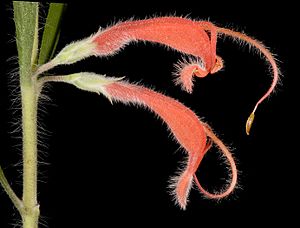Hairy jugflower facts for kids
Quick facts for kids Hairy jugflower |
|
|---|---|
 |
|
| Scientific classification | |
| Genus: |
Adenanthos
|
| Species: |
barbiger
|
| Synonyms | |
|
Adenanthos intermedius Ostenf. |
|
The Hairy Jugflower (scientific name: Adenanthos barbiger) is a type of shrub that belongs to the Proteaceae plant family. It grows naturally only in the south-west part of Western Australia. This plant usually reaches about 1 meter (3 feet) tall. It has bright red flowers that mostly bloom between August and December. An English botanist named John Lindley first officially described this plant in 1839.
What it Looks Like
The Hairy Jugflower grows as a small shrub, either standing straight up or spreading out. It can reach up to 1 meter (3 feet) in height. Often, many stems grow from a special underground part called a lignotuber. This lignotuber helps the plant survive fires.
When the branches are young, they are covered in tiny hairs. As the plant gets older, these hairs disappear. The leaves are long and thin, up to 8 cm (3 inches) long but only about 7 mm (0.3 inches) wide. They are oval-shaped and do not have a leaf stalk.
The flowers appear mostly between August and December. They are bright red and shaped like a tube, about 25 mm (1 inch) long. These tubular flowers are covered in soft, silky white hairs. A long part called a style, about 40 mm (1.6 inches) long, sticks out from the flower.
How it Got its Name
The Hairy Jugflower was first officially named Adenanthos barbigera in 1839 by John Lindley. He was an English botanist. The name barbigera comes from the Latin word barba, which means "beard." This refers to the white, beard-like hairs on the flower.
Over time, the rules for naming plants changed. Now, plant names ending in -anthos are treated as masculine. So, the plant's name was changed to Adenanthos barbiger, which is the name used today.
Where it Grows
The Hairy Jugflower is found in Western Australia. It grows between the west coast and the Darling Range. You can find it from Toodyay in the north down to Manjimup in the south.
It is quite common in the northern and southern parts of its range. However, it seems to be less common in the middle areas. This plant mostly grows in jarrah forests. Sometimes, it can also be found in more open areas. It can grow in different types of soil.
Unfortunately, this plant is very sensitive to a plant disease called Phytophthora cinnamomi dieback. This disease can cause the plant to die.
Growing Hairy Jugflowers
People have been growing the Hairy Jugflower in gardens since 1845, especially in Great Britain. However, it is not widely grown today.
This plant is great for attracting birds to your garden. It can also handle frost well. New plants can be grown from cuttings. You can take new shoots from the underground lignotuber. These shoots will grow roots well if kept in a misty environment. The Hairy Jugflower needs soil that drains water well. It also prefers to grow in full sunlight or partial shade.
See also
 In Spanish: Adenanthos barbiger para niños
In Spanish: Adenanthos barbiger para niños

